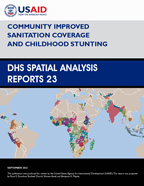- PUBLICATIONS
- JOURNAL ARTICLES
- ACCESS PUBLICATIONS
Publications Summary
- Document Type
- Spatial Analysis Reports
- Publication Topic(s)
- Adult Health Issues, Nutrition
- Country(s)
- Nigeria, Zambia
- Language
- English
- Recommended Citation
- Donohue, Rose E., Rachael Church, Shireen Assaf, and Benjamin K. Mayala. 2023. Community Improved Sanitation Coverage and Childhood Stunting. DHS Spatial Analysis Reports No. 23. Rockville, Maryland, USA: ICF
- Download Citation
- RIS format / Text format / Endnote format
- Publication Date
- September 2023
- Publication ID
- SAR23
Download
 Community Improved Sanitation Coverage and Childhood Stunting (PDF, 3825K)
Community Improved Sanitation Coverage and Childhood Stunting (PDF, 3825K)
 Community Improved Sanitation Coverage and Childhood Stunting (SAR23) - Analysis Brief
Community Improved Sanitation Coverage and Childhood Stunting (SAR23) - Analysis Brief
Download this publication
Associated publication(s):
There is no printed copy available to order.
